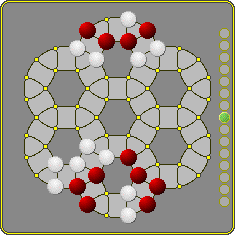Lotus

Lotus is a Go variant invented by Christian Freeling in the early eighties and played on the vertices of the depicted board. A point has four or three liberties, depending on whether it belongs to the infield or a 'corner', or an edge. The track on the side allows komi points to be set, and points for passing.
Lotus features othelloanian capture and has an additional safety mechanism called a rosette: a group containing six like colored stones around a grey hex lives unconditionally. Seki may occur and suicide is legal.
Lotus is the support act of Medusa.
Rules
The game starts on an empty board. Play is on the intersections. A point in the center has four neighbors, one on the edge has three and an inward corner again has four. Each player has a sufficient number of bi-colored stones. Next to the board is a 15-point track marked in the center. It can be used to set komi and to keep track of points earned by passing.
Moving
- Players move in turn. White moves first. A move consists of placing a stone on a vacant point. Moving is not compulsory: a player may pass his turn without losing the right to move on his next turn.
- If a player passes his turn, he moves the marker one point towards him. The player at whose side the marker is at the end of the game, receives the corresponding number of points in addition to the points he has on the board.
- A group consists of a single stone or several connected stones of the same color. The liberties of a group are the adjacent vacant points. The stones in a group share the group's liberties.
- A group lives unconditionally if it contains a lotus - six stones around one of the boards seven hexagons. A group without a lotus lives as long as it has at least one liberty.
Capture
Assuming none of the groups involved is protected by a lotus, a move may result in:
- One or more opponent's groups without a liberty. These are captured and reversed in the same turn. A captured group thus unites the groups responsible for its capture into one new group. This new group may itself have no liberties. In that case the original capture was suicidal and a subsequent reversal follows.
- One or more friendly groups without a liberty. If, at the same time, the conditions under 1 are met, the procedure described there is followed. If not, the move is suicidal. Suicide is legal.
- Neither 1 nor 2.
Object and counting
The game ends by one player's resignation or if both pass completely on successive turns. In the latter case dead stones are removed or reversed. The winner is now the player with the most territory. Territory consists of a player's number of stones on the board plus the number of cells totally surrounded by his stones. The player whose side it is on, also adds the number of points indicated by the marker.
Seki may occur: only cells totally surrounded by one player's color count in a seki.
Examples

An example of suicidal capture is black capturing the white stone at the top of the diagram: the resulting black group is itself dead and must be reversed. A white move at that point is a regular capture.
The two vacant points at the bottom are in a seki and count for neither player.
External links
Lotus at mindsports.nl:
![[ext]](images/extlink.gif) http://mindsports.nl/index.php/the-pit/538-lotus
http://mindsports.nl/index.php/the-pit/538-lotus
Lotus featured in R. Wayne Schmittberger's 'New Rules for Classic Games' (John Wiley & Sons, Inc. New York; ISBN 0-471-53621-0)
![Sensei's Library [Welcome to Sensei's Library!]](images/stone-hello.png)